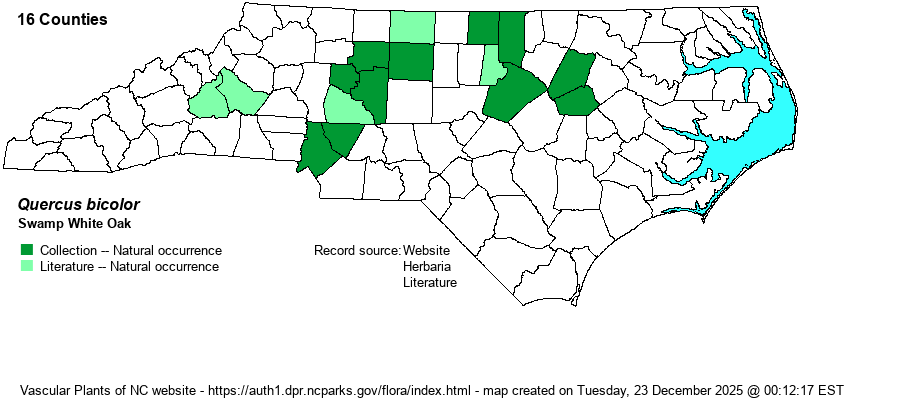| Author | Willdenow | |
| Distribution | Widely scattered over the Piedmont and the extreme northwestern edge of the Coastal Plain; ranges from Nash and Wilson counties on the east to McDowell County in the west. However, seemingly absent in the southeastern Piedmont and also in the northwestern counties of this province.
This is a Northern/Midwestern species that ranges from southeastern Canada south to SC and northern AL. It is most widespread from OH to MO, and is generally scarce in montane areas.
| |
| Abundance | Rare in the Piedmont, and very rare (if still present) in the edge of the Coastal Plain. Somewhat more widespread in counties near or along the VA border, from Granville to Rockingham, than in the southern portions, where very rare to locally rare. Seldom does one see more than just a handful of trees at any given site. This is a Watch List species in NC. | |
| Habitat | This has one of the more restricted habitats of any oak in NC, being limited to poorly drained bottomlands, drier portions of swamps, and floodplain pools, especially in Upland Depression Swamp Forest natural community. However, specimens from Cabarrus County are in dry and thin soil but over the famous syenite ring dike. It is limited to fairly high pH soils, particular Iredell soil type. The combination of circumneutral soil and forested non-flowing wetlands is very limited over the landscape. |
| Phenology | Flowers in April, and fruits in September of the same year. | |
| Identification | Though a familiar tree farther north and west of the Appalachians, few people are likely to run across this species in NC unless specifically targeting it. It is a medium deciduous tree, growing to 70-75 feet tall on average. It is mainly the leaves that are used for identification, as it is easy for eager biologists to call the very common White Oak (Q. alba) as this species. Swamp White Oak has leaves with perhaps 5-7 pairs of shallow and rounded lobes on each side, and the leaf shape is obovate (wider toward the tip); they average 6-7 inches long. Most importantly, they are quite thick and glossy dark green above, and pale green below, some almost greenish-white below. White Oak has thin leaves that are not shiny above, the lobes are much longer (owing to deep sinuses), and the undersides are not whitish. Swamp White Oak leaves also tend to show a more cuneate (gradual) tapering of the leaf base toward the petiole. If in doubt, Swamp White Oak should always be found in damp flat ground -– wet hardwood flats, on very rich soil. It could also be confused with Swamp Chestnut Oak (Q. michauxii), which can also be found in non-flowing Piedmont wetlands; that species has thin leaves and a more standard obovate shape. | |
| Taxonomic Comments | None
| |
| Other Common Name(s) | None. Note that “White Oak” is a nested part of the species name, as Q. alba is universally named as White Oak, and not something like American White Oak or Eastern White Oak, for better clarity. However, the name “White Oak” for Q. alba has been in use for so long that when someone says that he or she saw “White Oak” in a forest plot, it is understood to be Q. alba and not any other oak species. | |
| State Rank | S2 | |
| Global Rank | G5 | |
| State Status | W1 | |
| US Status | | |
| USACE-agcp | FACW link |
| USACE-emp | FACW link |

